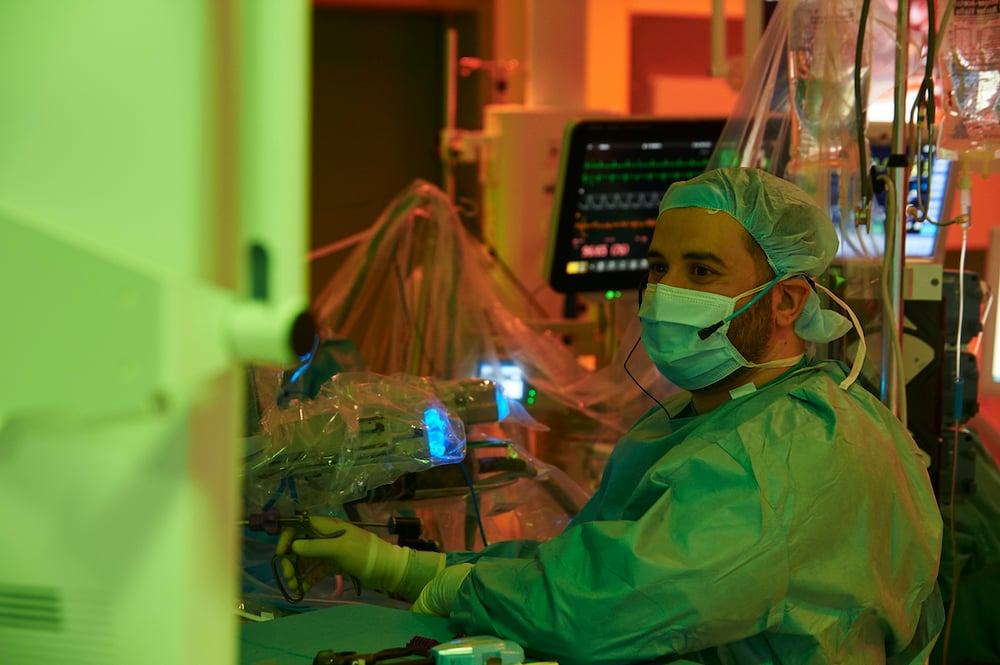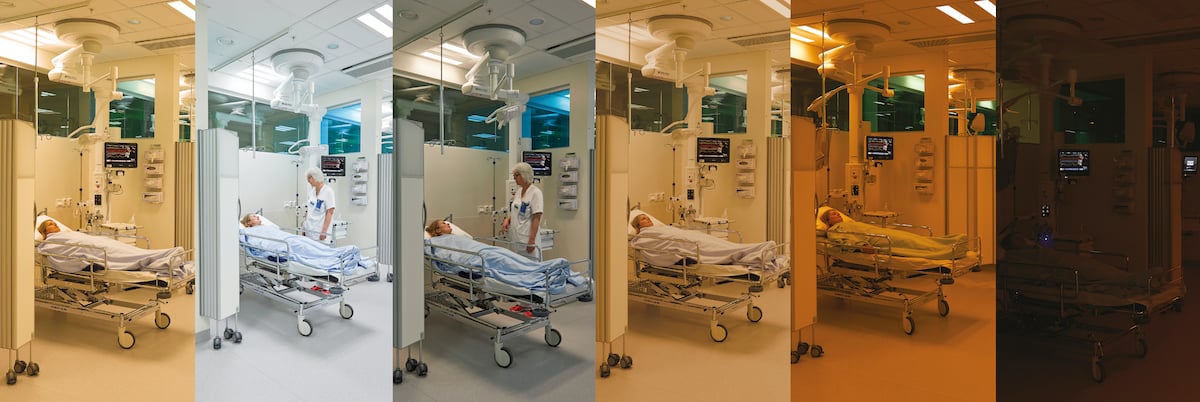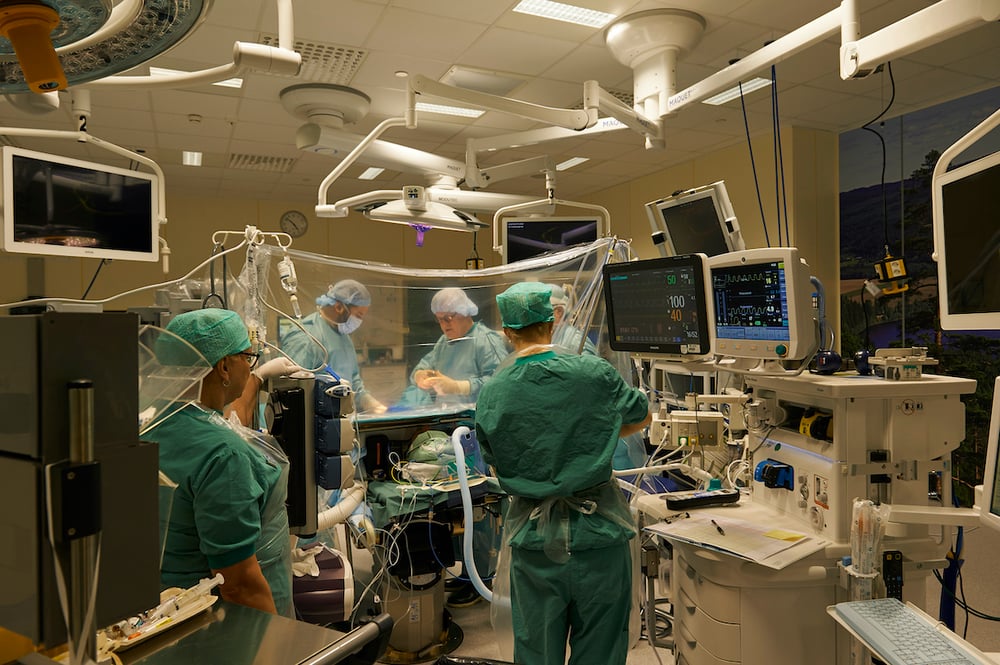As the first hospital in Sweden, the new surgical building in Karlstad has incorporated a comprehensive lighting solution - from the operating room to the recovery room and intensive care unit. This innovative approach creates an enhanced environment for patients, doctors, and nurses. Developed by the Danish company Chromaviso, the lighting concepts are based on the latest research and knowledge in the field.
— With the right lighting, we create a better working environment for the staff and a good setting for the patients, says Tobias Kjellberg, Head of Health and Medical Care.

Lights for Minimally Invasive Surgery
As more and more surgeries are being performed as minimally invasive procedures, surgeons are spending hours in front of screens, which can be strenuous on their eyes. This can also be challenging for the patients. To improve conditions for both patients and medical staff, all 25 new operating rooms at Centralsjukhuset have implemented Ergonomic Lighting. This innovative lighting concept combines the colours green and red and divides the room into different light zones based on the task at hand. The result is reduced eye strain, decreased fatigue, and improved quality, according to the experiences at Centralsjukhuset.
— By combining the complementary colours of red and green, we enhance the image quality on the screens and create a balanced and pleasant light throughout the room. Installing this lighting in all operating rooms in the new building ensures that it is utilized during every surgery, explains Tobias Kjellberg.
The lighting concept was developed in 2006 by the Danish company Chromaviso in collaboration with doctors and researchers, taking into account the different specialities and professional groups in an operating room. Since then, the concept has been further developed and is now installed in over 750 locations throughout Scandinavia, as well as being included in several research projects. In Sweden, more than 20 hospitals have chosen this lighting solution, including Södersjukhuset, Östra Sjukhus, and Skånes Universitetssjukhus.

— The lighting in the operating rooms is incredibly comfortable to work in, and there are no reflections on the screens. Whether we are moving around during surgery or switching between different procedures like laparoscopy, robot surgery, or open surgery, the lighting seamlessly adjusts to our needs. It's truly remarkable, explains Dr. Marina Sorensson from Centralsjukhuset.
Each room is equipped with nine pre-programmed settings, ensuring that no two rooms are the same. The lighting settings are tailored to each individual room, supporting the various workflows before, during, and after surgery.
— At Centralsjukhuset, we have gone into every room and programmed the lighting based on different procedures, user needs, and our knowledge of lighting and experiences from similar installations. We adjust the colours and light intensity to the room conditions, screen placements, and work zones. During complex surgeries, such as in the hybrid room, multiple lighting settings are used throughout the same operation. Therefore, we focus on making the controls extremely user-friendly and training the entire staff to use the lighting, explains Claus Puggaard, Sales Director and Partner at Chromaviso.
Chromaviso specializes in lighting for the healthcare sector and has been present in hospitals for the past ten years.
Circadian lighting for recovery and intensive care
After the surgery is completed, the patient is moved to the recovery room. Here, they are greeted by an automated circadian lighting system that adjusts itself according to the natural light outside. It mimics the sunrise in the morning, reaches its peak intensity during the day, and in the evening, it transitions to a warm, amber light that is free of blue wavelengths.

The lighting concept was developed by Chromaviso in collaboration with clinicians, leading chronobiologists, and sleep researchers to support the natural circadian rhythm of both staff and patients - a challenge often faced during hospitalization and night shifts. The lighting is based on a specially designed light protocol that ensures the right balance of intensity and spectrum throughout the day, with blue-free light during the night. This light protocol has been clinically validated in international research projects, including at Rigshospitalet, to ensure a physiological effect in terms of improved awakening, alertness, energy, and high-quality sleep.
— After just a few days, I already felt more refreshed. When I arrive in the morning, the light is starting to rise, and we wake up with the light, so to speak. It's incredibly pleasant, explains Inger Pettersen, a nurse at the hospital. She works in the light both day and night, and the warm night light has made a difference.
— The nighttime lighting is delightful. It provides a soothing and calming effect for both the staff and the patients. It's not too harsh and creates a pleasant atmosphere. When we need more light near the patient, we use one of the lighting settings at each bedside. But I also use the warm night light for reading and writing, she explains.
The natural light in the recovery room is carefully designed to support the body's circadian rhythm, promoting a sense of well-being and enhancing the recovery process. This comprehensive lighting solution includes a wide spectrum of colours, excluding those that primarily affect wakefulness and sleep. As a result, the staff benefits from excellent visual conditions without disrupting their body's natural sleep-wake cycle. In addition to circadian lighting, the concept also offers a range of lighting settings in both white and coloured shades, specifically tailored to different tasks and patient-related activities.
When the intensive care unit is completed later this year, it will also be equipped with a circadian lighting system.
LED-based lighting solution
Designing a lighting solution that encompasses an entire hospital while maintaining the essential flexibility in individual operating rooms and patient beds is a groundbreaking achievement.
— It's a complete solution where programming, lighting design, and flexibility are completely new. In the operating rooms, the staff receives the right light exactly where they need it. In intensive care, patients and staff have the ability to control the light near each bed, says Leif Fransson, project manager at MIDROC, responsible for electrical contracting in the construction.
At the same time, the lighting incorporates the latest LED technologies without compromising on reliability. The fixtures are specially designed to have very low glare, allowing the light to be transported in a comfortable manner.
The ambitious lighting project has succeeded through a collaborative effort throughout the construction process - from initial consultation to design, implementation, and commissioning.
— In the design phase, we worked closely with Chromaviso, going through each room together. This meant that we got it right the first time. It's incredible considering it's the largest and most advanced installation in Sweden, says Linus Idermark from Sweco, the consulting engineers on the project.

The decision to choose the Danish company Chromaviso was the result of a thorough decision-making process and several years of collaboration and dialogue about various possibilities, explained Tobias Kjellberg.
— Chromaviso has been a great partner since 2007 when we first installed Ergonomic Lighting. They provide highly competent advice and have proven over the years that they also follow up with user implementation. So when we had to choose a supplier for the new building, we considered factors such as effectiveness, price, and expertise. And we all agreed that Chromaviso provided the best overall solution, he says.
Chromaviso has been involved in the process from initial analysis and advice to design, integration, programming, user training, and follow-up and fine-tuning. The lighting solution was ready as planned and has functioned seamlessly from day one.
— High reliability starts right from the analysis and advice stage. Here, we ensure the right setup and thorough design. Once everything is delivered and installed, another crucial phase begins, namely the integration with the users. It should be a natural part of their routines to change the lighting and use it actively because it improves their work environment. We have been installing Ergonomic Lighting since 2006, so our products and implementation have been thoroughly tested to ensure they work from the first day of operation, concludes Claus Puggaard from Chromaviso.
About the solution
- The entire hospital spans a total of 28,000 square meters, offering a comprehensive lighting solution from the operating rooms to the recovery rooms and intensive care units.
- Ergonomic Lighting is installed in all 19 operating theatres including a hybrid room, a robot room, four endoscopy rooms, and two ERCP rooms.
- Additionally, the recovery rooms and intensive care units are equipped with a circadian lighting system, covering 18 recovery beds, monitoring rooms, intensive care beds, corridors, and common areas.

